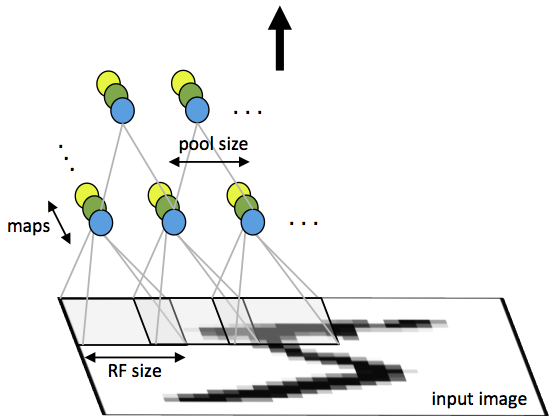斯坦福大学卷积神经网络教程UFLDL Tutorial - Convolutional Neural Network
Convolutional Neural Network
Overview
A Convolutional Neural Network (CNN) is comprised of one or more convolutional layers (often with a subsampling step) and then followed by one or more fully connected layers as in a standard multilayer neural network. The architecture of a CNN is designed to take advantage of the 2D structure of an input image (or other 2D input such as a speech signal). This is achieved with local connections and tied weights followed by some form of pooling which results in translation invariant features. Another benefit of CNNs is that they are easier to train and have many fewer parameters than fully connected networks with the same number of hidden units. In this article we will discuss the architecture of a CNN and the back propagation algorithm to compute the gradient with respect to the parameters of the model in order to use gradient based optimization. See the respective tutorials on convolution andpooling for more details on those specific operations.
Architecture
A CNN consists of a number of convolutional and subsampling layers optionally followed by fully connected layers. The input to a convolutional layer is a m x m x rm x m x r image where mm is the height and width of the image and rr is the number of channels, e.g. an RGB image has r=3r=3. The convolutional layer will have kk filters (or kernels) of size n x n x qn x n x q where nn is smaller than the dimension of the image and qq can either be the same as the number of channels rr or smaller and may vary for each kernel. The size of the filters gives rise to the locally connected structure which are each convolved with the image to produce kk feature maps of size m−n+1m−n+1. Each map is then subsampled typically with mean or max pooling over p x pp x p contiguous regions where p ranges between 2 for small images (e.g. MNIST) and is usually not more than 5 for larger inputs. Either before or after the subsampling layer an additive bias and sigmoidal nonlinearity is applied to each feature map. The figure below illustrates a full layer in a CNN consisting of convolutional and subsampling sublayers. Units of the same color have tied weights.

Fig 1: First layer of a convolutional neural network with pooling. Units of the same color have tied weights and units of different color represent different filter maps.
After the convolutional layers there may be any number of fully connected layers. The densely connected layers are identical to the layers in a standard multilayer neural network.
Back Propagation
Let δ(l+1)δ(l+1) be the error term for the (l+1)(l+1)-st layer in the network with a cost function J(W,b;x,y)J(W,b;x,y)where (W,b)(W,b) are the parameters and (x,y)(x,y) are the training data and label pairs. If the ll-th layer is densely connected to the (l+1)(l+1)-st layer, then the error for the ll-th layer is computed as
and the gradients are
If the ll-th layer is a convolutional and subsampling layer then the error is propagated through as
Where kk indexes the filter number and f′(z(l)k)f′(zk(l)) is the derivative of the activation function. The upsampleoperation has to propagate the error through the pooling layer by calculating the error w.r.t to each unit incoming to the pooling layer. For example, if we have mean pooling then upsample simply uniformly distributes the error for a single pooling unit among the units which feed into it in the previous layer. In max pooling the unit which was chosen as the max receives all the error since very small changes in input would perturb the result only through that unit.
Finally, to calculate the gradient w.r.t to the filter maps, we rely on the border handling convolution operation again and flip the error matrix δ(l)kδk(l) the same way we flip the filters in the convolutional layer.
Where a(l)a(l) is the input to the ll-th layer, and a(1)a(1) is the input image. The operation (a(l)i)∗δ(l+1)k(ai(l))∗δk(l+1) is the “valid” convolution between ii-th input in the ll-th layer and the error w.r.t. the kk-th filter.
from: http://ufldl.stanford.edu/tutorial/supervised/ConvolutionalNeuralNetwork/
斯坦福大学卷积神经网络教程UFLDL Tutorial - Convolutional Neural Network的更多相关文章
- 树卷积神经网络Tree-CNN: A Deep Convolutional Neural Network for Lifelong Learning
树卷积神经网络Tree-CNN: A Deep Convolutional Neural Network for Lifelong Learning 2018-04-17 08:32:39 看_这是一 ...
- 深度学习笔记 (一) 卷积神经网络基础 (Foundation of Convolutional Neural Networks)
一.卷积 卷积神经网络(Convolutional Neural Networks)是一种在空间上共享参数的神经网络.使用数层卷积,而不是数层的矩阵相乘.在图像的处理过程中,每一张图片都可以看成一张“ ...
- 卷积神经网络用语句子分类---Convolutional Neural Networks for Sentence Classification 学习笔记
读了一篇文章,用到卷积神经网络的方法来进行文本分类,故写下一点自己的学习笔记: 本文在事先进行单词向量的学习的基础上,利用卷积神经网络(CNN)进行句子分类,然后通过微调学习任务特定的向量,提高性能. ...
- Deep Learning 19_深度学习UFLDL教程:Convolutional Neural Network_Exercise(斯坦福大学深度学习教程)
理论知识:Optimization: Stochastic Gradient Descent和Convolutional Neural Network CNN卷积神经网络推导和实现.Deep lear ...
- Deep Learning 8_深度学习UFLDL教程:Stacked Autocoders and Implement deep networks for digit classification_Exercise(斯坦福大学深度学习教程)
前言 1.理论知识:UFLDL教程.Deep learning:十六(deep networks) 2.实验环境:win7, matlab2015b,16G内存,2T硬盘 3.实验内容:Exercis ...
- Deep Learning 1_深度学习UFLDL教程:Sparse Autoencoder练习(斯坦福大学深度学习教程)
1前言 本人写技术博客的目的,其实是感觉好多东西,很长一段时间不动就会忘记了,为了加深学习记忆以及方便以后可能忘记后能很快回忆起自己曾经学过的东西. 首先,在网上找了一些资料,看见介绍说UFLDL很不 ...
- Deep Learning 10_深度学习UFLDL教程:Convolution and Pooling_exercise(斯坦福大学深度学习教程)
前言 理论知识:UFLDL教程和http://www.cnblogs.com/tornadomeet/archive/2013/04/09/3009830.html 实验环境:win7, matlab ...
- Deep Learning 13_深度学习UFLDL教程:Independent Component Analysis_Exercise(斯坦福大学深度学习教程)
前言 理论知识:UFLDL教程.Deep learning:三十三(ICA模型).Deep learning:三十九(ICA模型练习) 实验环境:win7, matlab2015b,16G内存,2T机 ...
- Deep Learning 12_深度学习UFLDL教程:Sparse Coding_exercise(斯坦福大学深度学习教程)
前言 理论知识:UFLDL教程.Deep learning:二十六(Sparse coding简单理解).Deep learning:二十七(Sparse coding中关于矩阵的范数求导).Deep ...
随机推荐
- 微信小程序-textarea中的文本读取以及换行问题
今天客户那边要求textarea中输入的问题可以按回车键换行,而我使用的是bindinput获取值,但是呢bindinput 处理函数的返回值并不会反映到 textarea 上,按回车键导致点击换行符 ...
- NIO-5补充
import java.io.IOException; import java.nio.ByteBuffer; import java.nio.channels.FileChannel; import ...
- 解决序列化类型为“System.Reflection.RuntimeModule”的对象时检测到循环引用。
定义一个继承JavaScriptConverter的子类 public class DataTableConverter : JavaScriptConverter { /// <summary ...
- 在CentOS7命令行模式下安装虚拟机
转载:https://blog.csdn.net/sunnyfg/article/details/51493602 1.主机环境描述: 操作系统:CentOS7 系统GUI:无 CPU:Intel4代 ...
- HTML5实战与剖析之字符集属性(charset和defaultCharset)
HTML5对字符集属性也进行了更新,其中charset和defaultCharset属性就是HTML5中新添加的字符集属性.有关charset和defaultCharset属性的具体讲解尽在HTML5 ...
- Mac os 下的文件权限管理
Mac os 下的文件权限管理 命令 ls -l -A 结果 -rw-r--r-- 1 user admin 2326156 4 12 15:24 adb 横线代表空许可.r代表只读,w代表写,x代表 ...
- prim 算法和 kruskal算法
Prim算法 1.概览 普里姆算法(Prim算法),图论中的一种算法,可在加权连通图里搜索最小生成树.意即由此算法搜索到的边子集所构成的树中,不但包括了连通图里的所有顶点(英语:Vertex (gra ...
- BZOJ 4276: [ONTAK2015]Bajtman i Okrągły Robin
最大权值匹配,贪心匈牙利即可. 检查一些人是否能被全部抓住可以采用左端点排序,右端点优先队列处理. By:大奕哥 #include<bits/stdc++.h> using namespa ...
- BZOJ 3676: [Apio2014]回文串 后缀自动机 Manacher 倍增
http://www.lydsy.com/JudgeOnline/problem.php?id=3676 过程很艰难了,第一次提交Manacher忘了更新p数组,超时,第二次是倍增的第0维直接在自动机 ...
- finish/onDestroy/System.exit()的区别
Activity.finish():Call this when your activity is done and should be closed. 在你的activity动作完成的时候,或者Ac ...
